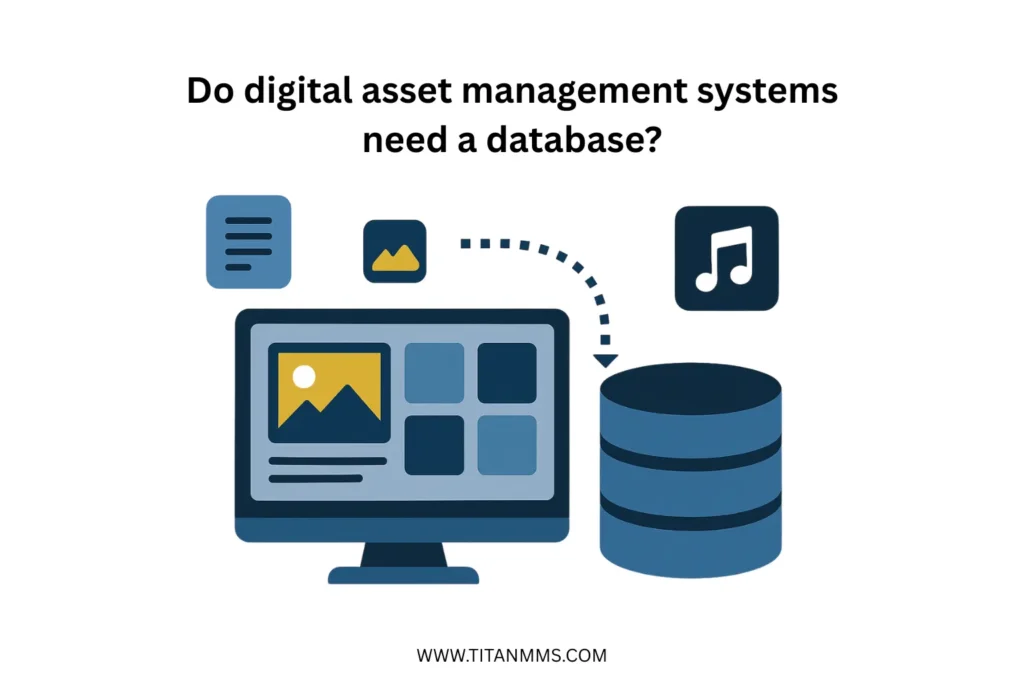Introduction: Why a Database is Essential for DAM Systems
In today’s digital-first world, businesses generate and manage thousands of assets—logos, videos, presentations, and product images. A Digital Asset Management (DAM) system is the key to organizing, securing, and retrieving these assets efficiently. However, a critical question arises:
Do digital asset management systems need a database?
Yes! A database is the backbone of any DAM system, ensuring structured file storage, fast searches, metadata management, and security. Without a database, a DAM system becomes slow, inefficient, and difficult to scale.
This in-depth guide explores:
- How a database powers DAM systems
- Which types of databases work best
- How small businesses can leverage DAM software
- Best practices for effective digital asset management
By the end, you’ll understand why a database is critical for DAM software and how to choose the best solution for your business.

What is a Digital Asset Management (DAM) System?
A Digital Asset Management (DAM) system is a centralized platform that helps businesses store, manage, and distribute digital files efficiently. It’s an essential tool for marketing teams, content creators, and e-commerce businesses.
Key Benefits of a DAM System
- Faster File Retrieval – Find assets instantly with a metadata-based search.
- Secure Asset Storage – Organize digital files with permissions and role-based access.
- Improved Collaboration – Share files with team members, clients, or partners.
- Version Control & Compliance – Track asset history, ensuring only approved versions are used.
A DAM system without a database would be like a library without a catalog—finding what you need would be nearly impossible!
Why Do Digital Asset Management Systems Need a Database?
A database is what allows DAM software to store, index, and retrieve files efficiently. Here’s why it’s essential:
1. Efficient Digital Asset Organization
A database structures files into categories and folders, preventing asset duplication and disorganization.
2. Instant Search & Metadata Tagging
A DAM database indexes metadata (file names, descriptions, keywords, categories), allowing users to find assets in seconds.
3. Version Control & Asset Tracking
A DAM system database logs every change, preventing accidental overwrites and lost versions.
4. Secure File Management
Databases allow role-based access control, ensuring that only authorized users can modify assets.
5. Scalability for Business Growth
As companies expand, their DAM system database must scale to handle increasing assets without slowdowns.
💡 Pro Tip: Businesses using digital asset management for small businesses should choose cloud-based DAM software with a scalable database for future growth.
Challenges of Using Databases in DAM Systems
While databases enhance DAM systems, they also present challenges.
1. Implementation Complexity
Setting up a DAM database requires expertise in digital asset management implementation and database configuration.
2. Cost Considerations
Enterprise-grade SQL servers can be expensive, but cloud-based DAM solutions offer cost-effective alternatives for digital asset management for small businesses.
3. Performance Optimization
As digital libraries grow, DAM best practices recommend regular indexing and maintenance to keep search speeds high.
Best Databases for Digital Asset Management Systems
Choosing the right database for a DAM system depends on business size, data structure, and asset volume.
1. Relational Databases (SQL-Based)
Structured databases organize metadata and asset relationships in tables.
- Best for: Large enterprises with complex metadata needs.
- Examples: MySQL, PostgreSQL, Microsoft SQL Server.
2. NoSQL Databases
Flexible, scalable solutions for handling unstructured data.
- Best for: DAM software managing videos, images, and documents.
- Examples: MongoDB, Cassandra, Elasticsearch.
3. Hybrid Databases (SQL + NoSQL)
Combine structured metadata with scalable, high-performance storage.
- Best for: Businesses needing fast search and scalability.
- Examples: AWS DynamoDB, Google Firestore.
💡 Pro Tip: For small businesses, a cloud-based NoSQL solution is cost-effective, while enterprises may prefer SQL-based databases for structured metadata.
How Small Businesses Can Leverage Digital Asset Management
Many assume that DAM systems are for large corporations, but digital asset management for small businesses is equally important.
- Use a Cloud-Based DAM System – No need for expensive hardware or IT teams.
- Automate Asset Tagging – Save time by auto-labeling images and videos.
- Optimize Metadata for SEO – Make assets searchable with clear titles and descriptions.
💡 Pro Tip: Businesses using digital asset management software for small businesses should look for low-cost, scalable solutions like Brandfolder, Bynder, or Canto.
Digital Asset Management Best Practices
To ensure a successful digital asset management implementation, follow these DAM best practices:
1. Implement a Metadata Strategy
- Define consistent categories, keywords, and tags.
- Use AI-powered auto-tagging to speed up classification.
2. Use Role-Based Access Control
- Limit file access to only necessary team members.
- Prevent accidental modifications or deletions.
3. Archive & Backup Assets Regularly
- Store outdated assets in archives to free up database space.
- Use cloud backups to prevent data loss.
4. Optimize for Speed & Performance
- Choose a fast, scalable database to handle large digital libraries.
- Regularly optimize database indexing for faster asset retrieval.
5. Integrate DAM with Other Business Tools
- Connect DAM software with project management, CMS, and marketing tools for better workflow automation.
Following these DAM best practices ensures efficient asset management, improved collaboration, and long-term business success.
Conclusion
A DAM system without a database is like a search engine without an index completely ineffective. So, do digital asset management systems need a database? Absolutely! A database is the foundation of a DAM system, ensuring organized storage, fast retrieval, and enhanced security. Without it, managing thousands of digital assets would be inefficient and chaotic.
Key Takeaways:
- A database powers search, organization, security, and scalability in DAM systems.
- Relational (SQL) databases are great for structured metadata, while NoSQL is ideal for large media storage.
- Digital asset management for small businesses benefits from cloud-based, scalable DAM solutions.
- Following DAM best practices improves efficiency, security, and searchability.
Investing in a DAM system with a powerful database is essential for businesses aiming to streamline workflows, improve digital strategy asset management, and enhance productivity.
📌 Next Step: Choose a DAM software with the right database for your business needs and implement best practices to maximize its potential.
Frequently Asked Question
Technically, yes, but it would lack search capabilities, metadata organization, and version control, making it inefficient.
SQL databases (e.g., MySQL, PostgreSQL) work best for structured metadata.
NoSQL databases (e.g., MongoDB, Elasticsearch) handle large, unstructured asset libraries.
Without a database, DAM systems become slow, unstructured, and inefficient, leading to Difficult file retrieval, no version control, and Security risks.
Look for: Cloud storage, Fast search capabilities, and Integration with business tools
Yes. Cloud-based digital asset management software for small businesses offers Lower costs, Remote access, and Automatic backups.
